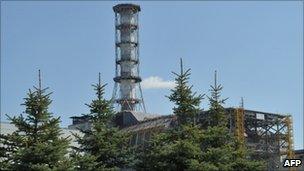Chernobyl new radiation shield funding fall short
- Published

The steel sarcophagus at Chernobyl is nearing the end of its life
An international conference called to raise funds for new safety measures at the site of the 1986 Chernobyl disaster has fallen 25% short of its goal.
The Ukrainian government said it had raised 550m euros of the 740m euros ($1bn; £600m) it needed to finance a massive new radiation shield.
Ukraine's President Viktor Yanukovych said this was a "preliminary" figure.
Chernobyl, the world's worst nuclear accident, sent a plume of radiation over large parts of Europe.
"The catastrophe at Chernobyl power station left a deep wound that Ukraine will need to live with for many years ahead," Mr Yanukovych said at the conference in Kiev.
"We thank the international community for not leaving Ukraine alone with this problem."
Mr Yanukovych said that to turn Chernobyl into an "ecologically safe site", it was necessary "to build a new sarcophagus around the damaged reactor as well as a secure storage facility for spent nuclear fuel."
"The catastrophe has affected millions of people; thousands died and tens of thousands continue to suffer," Mr Yanukovych said.
According to a UN report, external, considered the most comprehensive to date on the disaster's health impact, Chernobyl directly caused the deaths of 30 workers and radiation injuries to more than 100 others.
Subsequently, more than 6,000 cases of thyroid cancer were reported in children and adolescents who were exposed at the time of the accident in Ukraine and Russia, with many of these cancers "most likely caused by radiation exposures shortly after the accident".
"Apart from this increase, there is no evidence of a major public health impact attributable to radiation exposure two decades after the accident," the UN assessment adds.
Gigantic shell
The conference, and a summit on nuclear power being held afterwards, coincide with preparations for the 25th anniversary of the accident next week.
The conference has been planned for years, but has gained new impetus with the continuing emergency at the Fukushima nuclear power plant in Japan.
Ukraine's government, along with the European Union and the European Bank for Reconstruction and Development, is building a gigantic new shell to cover Chernobyl's exploded reactor and the existing steel sarcophagus.
The sarcophagus was hastily built around the reactor just after the accident in 1986 to contain the radiation and is now nearing the end of its life.
The new structure will be the largest of its kind in the world - an arch more than 100m (328ft) high, 250m (820ft) wide and 160m (524ft) long.
It will be assembled away from the Chernobyl site and then slid into place over the damaged reactor, before the ends are blocked up. It is expected to give Ukraine 100 years to dispose of the nuclear waste.
European Commission President Jose Manuel Barroso said on Monday that the Commission would allocate an extra 110m euros ($156m) towards this and related Chernobyl projects.
"Recent events in Fukushima, Japan, have also reminded us of the danger this issue may represent," he said.
"We need today to reaffirm our solidarity."
- Published12 April 2011
- Published26 March 2011
- Published6 April 2011
- Published18 April 2011